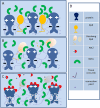Hypertonic saline- and detergent-accelerated EDTA-based decalcification better preserves mRNA of bones
- PMID: 38740835
- PMCID: PMC11091162
- DOI: 10.1038/s41598-024-61459-8
Hypertonic saline- and detergent-accelerated EDTA-based decalcification better preserves mRNA of bones
Abstract
Ethylenediaminetetraacetic acid (EDTA), a classically used chelating agent of decalcification, maintains good morphological details, but its slow decalcification limits its wider applications. Many procedures have been reported to accelerate EDTA-based decalcification, involving temperature, concentration, sonication, agitation, vacuum, microwave, or combination. However, these procedures, concentrating on purely tissue-outside physical factors to increase the chemical diffusion, do not enable EDTA to exert its full capacity due to tissue intrinsic chemical resistances around the diffusion passage. The resistances, such as tissue inner lipids and electric charges, impede the penetration of EDTA. We hypothesized that delipidation and shielding electric charges would accelerate EDTA-based penetration and the subsequent decalcification. The hypothesis was verified by the observation of speedy penetration of EDTA with additives of detergents and hypertonic saline, testing on tissue-mimicking gels of collagen and adult mouse bones. Using a 26% EDTA mixture with the additives at 45°C, a conventional 7-day decalcification of adult mouse ankle joints could be completed within 24 h while the tissue morphological structure, antigenicity, enzymes, and DNA were well preserved, and mRNA better retained compared to using 15% EDTA at room temperature. The addition of hypertonic saline and detergents to EDTA decalcification is a simple, rapid, and inexpensive method that doesn't disrupt the current histological workflow. This method is equally or even more effective than the currently most used decalcification methods in preserving the morphological details of tissues. It can be highly beneficial for the related community.
Keywords: Bone; Decalcification; Delipidation; EDTA; Histology; Technique.
© 2024. The Author(s).
Conflict of interest statement
The authors are paid employees of Advancecor GmbH of Germany and have read the journal’s policy. There are no patents, products in development, or marketed products associated with this research to declare.
Figures









References
-
- Alers JC, Krijtenburg PJ, Vissers KJ, van Dekken H. Effect of bone decalcification procedures on DNA in situ hybridization and comparative genomic hybridization. EDTA is highly preferable to a routinely used acid decalcifier. J. Histochem. Cytochem. 1999;47(5):703–10. doi: 10.1177/002215549904700512. - DOI - PubMed
-
- Arber JM, Weiss LM, Chang KL, Battifora H, Arber DA. The effect of decalcification on in situ hybridization. Mod. Pathol. 1997;10(10):1009–1014. - PubMed
-
- Kirita T. Oral Cancer. Springer Science + Business Media; 2015.
-
- An YH, Martin KL. Handbook of Histology Methods for Bone and Cartilage. Humana Press; 2003.
MeSH terms
Substances
LinkOut - more resources
Full Text Sources

